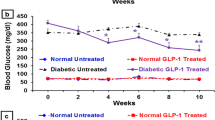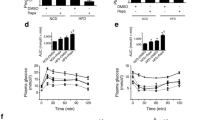Abstract
Background
Metformin is the most frequently prescribed drug for treatment of type 2 diabetes. It improves insulin resistance and glycemia by reducing hepatic gluconeogenesis. In addition, diabetic patients on metformin therapy have elevated levels of the insulinotropic hormone glucagon-like peptide-1 (GLP-1) and metformin has been shown to regulate the expression of the GLP-1R in the pancreas.
Methods
We have studied the direct long-term effects of metformin on apoptosis, and function of GLP-1-secreting L cells in vitro, using the murine GLUTag cell line as a model. The apoptosis of GLUTag cells was detected by DNA-fragment assay and caspase-3 activity determination. GLP-1 secretion was determined using ELISA and the expression of proglucagon mRNA was assessed by reverse transcription polymerase chain reaction. The activation of intracellular messengers was determined using western blotting.
Results
Metformin significantly decreased lipotoxicity-induced apoptosis in conjunction with increased phosphorylated AMPK. Metformin also countered the JNK2 activation evoked by lipotoxicity. In addition, long-term metformin treatment stimulated GLP-1 secretion.
Conclusion
This study demonstrates that metformin protects against lipoapoptosis (possibly by blocking JNK2 activation), and enhances GLP-1 secretion from GLP-1-producing cells in vitro. These direct effects of the drug might explain the elevated plasma GLP-1 levels seen in diabetic patients on chronic metformin therapy. The findings may also be harnessed to therapeutic advantage in efforts aiming at enhancing endogenous GLP-1 secretion in type 2 diabetic patients.





Similar content being viewed by others
Abbreviations
- AMPK:
-
AMP-activated protein kinase
- JNK2:
-
c-Jun N-terminal kinase
- GLP-1:
-
Glucagon-like peptide-1
- PKA:
-
Protein kinase A
- PKC:
-
Protein kinase C
References
Meetoo D, McGovern P, Safadi R. An epidemiological overview of diabetes across the world. Br J Nurs. 2007;16(16):1002–7.
Drucker DJ. The role of gut hormones in glucose homeostasis. J Clin Invest. 2007;117(1):24–32.
Meier JJ, Nauck MA. Glucagon-like peptide 1 (GLP-1) in biology and pathology. Diabetes Metab Res Rev. 2005;21(2):91–117.
Vilsboll T, Krarup T, Deacon CF, Madsbad S, Holst JJ. Reduced postprandial concentrations of intact biologically active glucagon-like peptide 1 in type 2 diabetic patients. Diabetes. 2001;50(3):609–13.
Rutter GA, Leclerc I. The AMP-regulated kinase family: enigmatic targets for diabetes therapy. Mol Cell Endocrinol. 2009;297(1–2):41–9.
Mannucci E, Ognibene A, Cremasco F, Bardini G, Mencucci A, Pierazzuoli E, et al. Effect of metformin on glucagon-like peptide 1 (GLP-1) and leptin levels in obese nondiabetic subjects. Diabetes Care. 2001;24(3):489–94.
Lee YC, Asa SL, Drucker DJ. Glucagon gene 5′-flanking sequences direct expression of simian virus 40 large T antigen to the intestine, producing carcinoma of the large bowel in transgenic mice. J Biol Chem. 1992;267(15):10705–8.
Lowry OH, Rosebrough NJ, Farr AL, Randall RJ. Protein measurement with the Folin phenol reagent. J Biol Chem. 1951;193(1):265–75.
Brubaker PL, Schloos J, Drucker DJ. Regulation of glucagon-like peptide-1 synthesis and secretion in the GLUTag enteroendocrine cell line. Endocrinology. 1998;139(10):4108–14.
Drucker DJ, Jin T, Asa SL, Young TA, Brubaker PL. Activation of proglucagon gene transcription by protein kinase-A in a novel mouse enteroendocrine cell line. Mol Endocrinol. 1994;8(12):1646–55.
Gribble FM, Williams L, Simpson AK, Reimann F. A novel glucose-sensing mechanism contributing to glucagon-like peptide-1 secretion from the GLUTag cell line. Diabetes. 2003;52(5):1147–54.
Hirasawa A, Tsumaya K, Awaji T, Katsuma S, Adachi T, Yamada M, et al. Free fatty acids regulate gut incretin glucagon-like peptide-1 secretion through GPR120. Nat Med. 2005;11(1):90–4.
Kleinfeld AM, Prothro D, Brown DL, Davis RC, Richieri GV, DeMaria A. Increases in serum unbound free fatty acid levels following coronary angioplasty. Am J Cardiol. 1996;78(12):1350–4.
Shafrir E. Partition of unesterified fatty acids in normal and nephrotic syndrome serum and its effect on serum electrophoretic pattern. J Clin Invest. 1958;37(12):1775–82.
Wu P, Yang L, Shen X. The relationship between GPR40 and lipotoxicity of the pancreatic beta-cells as well as the effect of pioglitazone. Biochem Biophys Res Commun. 2010;403(1):36–9.
Mishra R, Simonson MS. Saturated free fatty acids and apoptosis in microvascular mesangial cells: palmitate activates pro-apoptotic signaling involving caspase 9 and mitochondrial release of endonuclease G. Cardiovasc Diabetol. 2005;4(1):2.
Saifer A, Goldman L. The free fatty acids bound to human serum albumin. J. Lipid Res. 1961;2(3):268–70.
Sheehan MT, Jensen MD. Metabolic complications of obesity. Pathophysiologic considerations. Med Clin North Am. 2000; 84(2): 363–85, vi.
Tournier C, Hess P, Yang DD, Xu J, Turner TK, Nimnual A, et al. Requirement of JNK for stress-induced activation of the cytochrome c-mediated death pathway. Science. 2000;288(5467):870–4.
Kim DS, Jeong SK, Kim HR, Kim DS, Chae SW, Chae HJ. Metformin regulates palmitate-induced apoptosis and ER stress response in HepG2 liver cells. Immunopharmacol Immunotoxicol. 2010; 32(2): 251–7.
Hinke SA, Martens GA, Cai Y, Finsi J, Heimberg H, Pipeleers D, et al. Methyl succinate antagonises biguanide-induced AMPK-activation and death of pancreatic beta-cells through restoration of mitochondrial electron transfer. Br J Pharmacol. 2007;150(8):1031–43.
Schulz E, Dopheide J, Schuhmacher S, Thomas SR, Chen K, Daiber A, et al. Suppression of the JNK pathway by induction of a metabolic stress response prevents vascular injury and dysfunction. Circulation. 2008;118(13):1347–57.
Xie Z, Dong Y, Scholz R, Neumann D, Zou MH. Phosphorylation of LKB1 at serine 428 by protein kinase C-zeta is required for metformin-enhanced activation of the AMP-activated protein kinase in endothelial cells. Circulation. 2008;117(7):952–62.
Yi F, Sun J, Lim GE, Fantus IG, Brubaker PL, Jin T. Cross talk between the insulin and Wnt signaling pathways: evidence from intestinal endocrine L cells. Endocrinology. 2008;149(5):2341–51.
Jin T. Why diabetes patients are more prone to the development of colon cancer? Med Hypotheses. 2008;71(2):241–4.
Isoda K, Young JL, Zirlik A, MacFarlane LA, Tsuboi N, Gerdes N, et al. Metformin inhibits proinflammatory responses and nuclear factor-kappaB in human vascular wall cells. Arterioscler Thromb Vasc Biol. 2006;26(3):611–7.
Scheen AJ. Clinical pharmacokinetics of metformin. Clin Pharmacokinet. 1996;30(5):359–71.
Proctor WR, Bourdet DL, Thakker DR. Mechanisms underlying saturable intestinal absorption of metformin. Drug Metab Dispos. 2008;36(8):1650–8.
Acknowledgments
This work was generously supported financially by Stiftelsen Olle Engkvist Byggmästare, an EFSD/Amylin research grant, and Stiftelsen Sigurd and Elsa Goljes Minne.
Conflict of interest
No conflicts of interest, financial or otherwise, are declared by the authors.
Author information
Authors and Affiliations
Corresponding author
Rights and permissions
About this article
Cite this article
Kappe, C., Patrone, C., Holst, J.J. et al. Metformin protects against lipoapoptosis and enhances GLP-1 secretion from GLP-1-producing cells. J Gastroenterol 48, 322–332 (2013). https://doi.org/10.1007/s00535-012-0637-5
Received:
Accepted:
Published:
Issue Date:
DOI: https://doi.org/10.1007/s00535-012-0637-5




